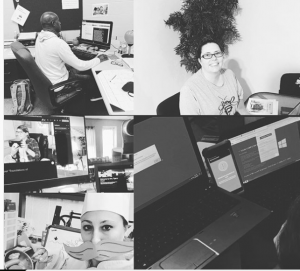
Hello everyone,
I talked to some of my colleagues about the hurdles they face with technology and teaching in our present situation. We are currently distance teaching, everyone is teaching through MS Teams. However, We have Kindergarten, 1st, and self-contained sped students returning to a hybrid scenario in one week, and one week after that is 2nd, 3rd, and 4th graders are returning.
Timberlake is a Kindergarten teacher and Madden is a 1st-grade teacher both at Lincoln. They expressed similar hurdles with teaching with technology from a distance.
Timberlake said, ““Most of them have no experience with technology, other than maybe a phone or tablet to play games. Also, they can’t read or spell, so giving directions can be difficult if there aren’t obvious pictures for them to use.” and Madden mentioned, ““Some students have not had many experiences with typing on a computer so they type in random numbers and symbols to try and complete their work. There is also the difficulty with some programs not allowing audio for read-aloud directions. Another hurdle is the multiple steps it takes to complete an assignment and turn it in.”
They both struggle with the early learners with technology having no experience or very limited, hence why they are in the first group to return to a hybrid scenario. The student’s parents have to help the learners big time in both situations, students who do not have parents, other adults, older siblings to help them, then are they getting any type of education.
The return to in-person learning is their way to over this hurdle, but parents who opt to keep their student home need to have a way to have someone older to help that student get a quality education.
Mrs. Tyler is a 6th-grade teacher, on my team at Lincoln, and she exclaimed, “Technology can be distracting for them because when they have access to do other things besides their work they have a hard time concentrating on what they should actually be doing. It’s a temptation some can’t handle well.”
In the article, “Ten reasons teachers can struggle to use technology in the classroom”, they talk about students getting distracted with technology, and Mrs. Tyler spoke of this in our conversation.
When it comes to the middle school students, teaching and modeling how to use technology correctly is a constant teaching moment in our classrooms. Students know how to operate technology that they want to learn or figure out, but programs and websites that the teacher wants them to learn, they have to learn from the teacher and do not have the motivation to learn it. Teaching students and contacting parents is the way to overcome this hurdle.
Mr. Jackson is a new AP in our district, but has been an administrator in other districts, and has worked in our district before as a TA and teacher. He mentioned, ““The major difference in my role is how I evaluate teachers. I’m using a virtual platform to observe teachers instead of being in the classroom and actually seeing how the students respond to the lesson. The engagement part is difficult to judge because of the technology problems and other family issues you just going to have dealing with our population of students.” His job has a whole new learning curve to evaluate teachers and gage engagement amongst students.
As a teacher, it is very hard to gauge engagement. When students are participating then they are engaged in the lesson, but students who do not participate or engage, struggle with assignments and tasks presented to them. Also, our district scratched the idea of teacher evaluations this year, so no teacher is being evaluated like prior, but feedback is given to teachers to improve their instructional practice.
Crystal Monast is our current instructional coach but has been reassigned as a 2nd-grade virtual teacher, which is a teacher who has a class that does the Accellus program. This is a flexible program, where students do the work when it is convenient for them, and she meets with parents/families on a weekly basis to check-in. The parent takes on more of the educational needs and works with their child, where the teacher checks and monitors their work, and resets it if needed. She exclaimed, ““The quality of instruction is not the same through a computer compared to the instruction of in-person learning”
I agree that quality education is better in the presence of a teacher. However, our students right now get a teacher presented a lesson on the distance plan five days a week. When they return they will be with a teacher 2-3 times a week, which one is better, and provides better quality?
All of these individuals present different hurdles, and all of them will have different plans to overcome those hurdles. The overall consensus of these hurdles is that we were not prepared to teach through a computer; however, the staff has been positive and has done their best with the given situation.
Modeling and teaching every student in every grade how to complete assignments, communicate, and work with technology is a plan to overcome many hurdles across the school and grade levels.
Furthermore, in the article, “Ten reasons teachers can struggle to use technology in the classroom”, one thing I noticed that was not talked about or barely mentioned was time. Teachers need time to explore, hang out, mess around with technology. Not all teachers are tech experts, which they mentioned, so they need time to become experts or adequate users to use with students.
Signing off,
Jamirson
